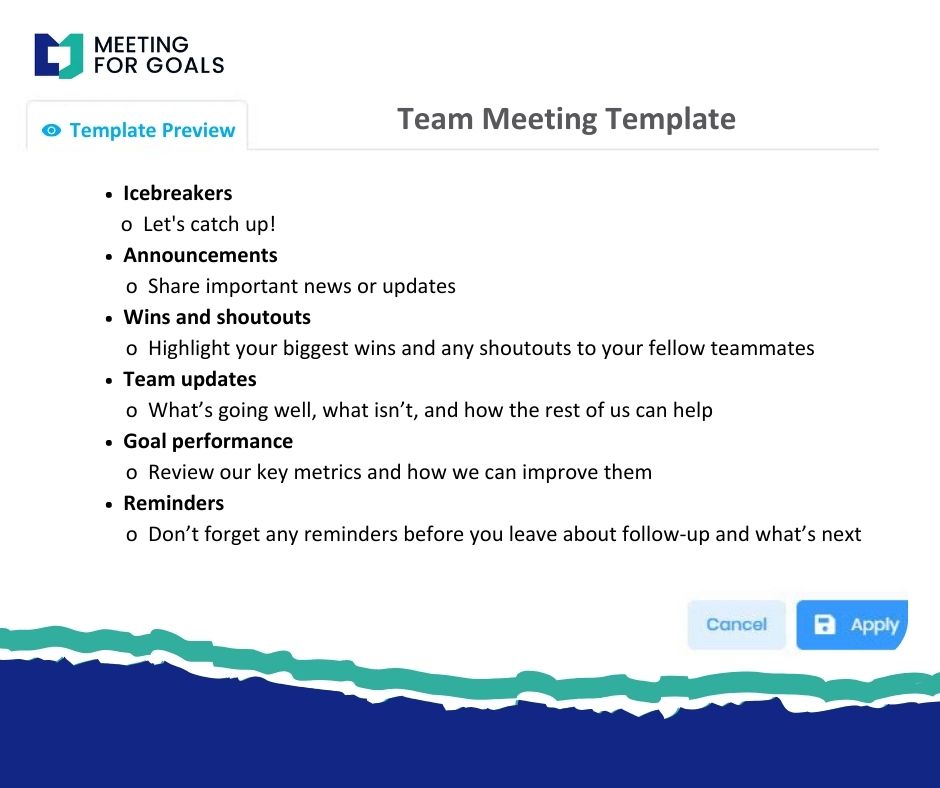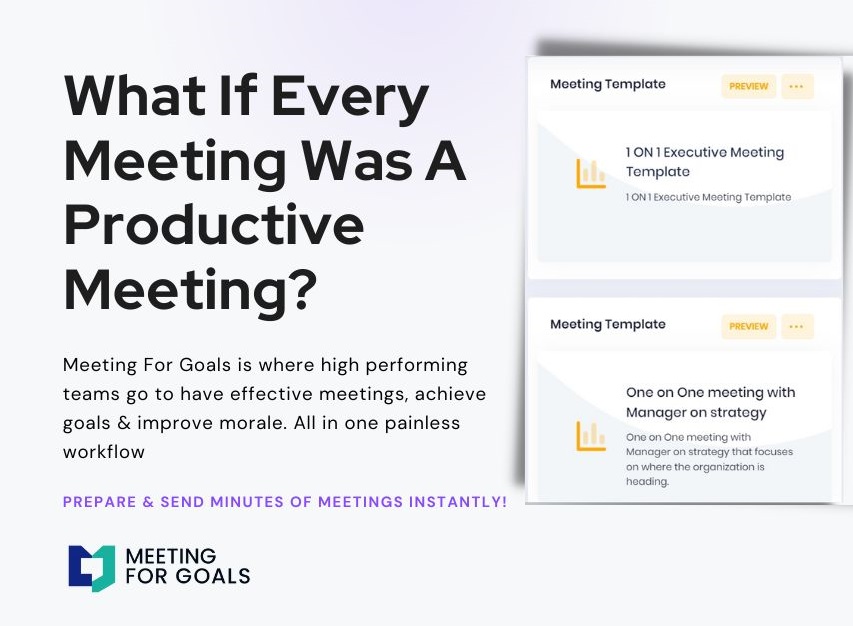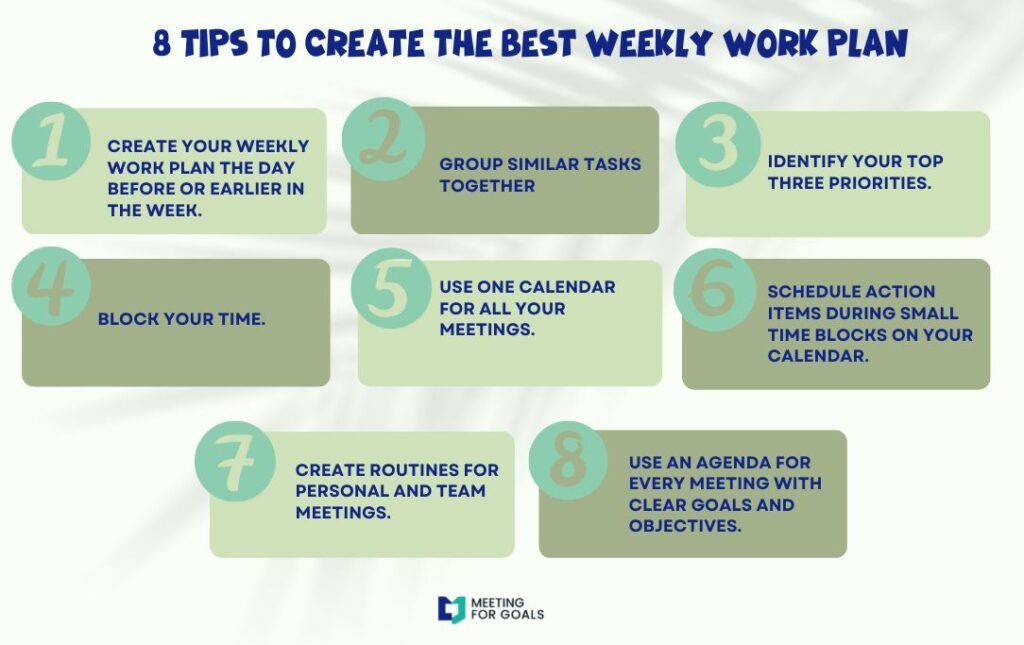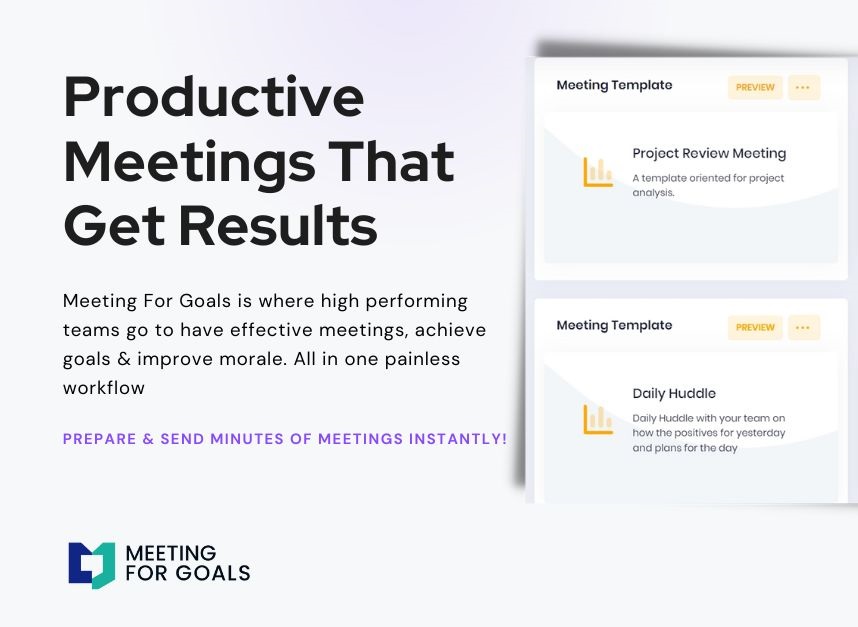The Ultimate Team Meeting Agenda Template: Boost Productivity with Every Meeting
Meetings are the heartbeat of high-performing teams—but only when they’re run effectively. Without structure, meetings can quickly become time-wasting and morale-draining events. That’s why having a solid team meeting agenda template is essential. In this guide, we’ll walk you through a proven six-step agenda framework designed for leadership teams in growing companies. Plus, we’ll show you how Meeting for Goals, our powerful meeting management software, can help you streamline every meeting, align discussions with company objectives, and drive accountability—so your team can focus on what really matters: achieving results.
Introduction
In today’s fast-paced business world, time is money—literally. For growing companies with 40 to 70 employees, especially those led by Directors, VPs, and C-suite executives, every meeting needs to be purposeful and efficient.
Yet, research shows that up to 50% of meeting time is wasted due to poor planning and lack of structure. According to Harvard Business Review, poorly run meetings can cost businesses millions in lost productivity annually. That’s a staggering figure—and one that can be avoided with the right tools and processes.
This is where a well-crafted team meeting agenda comes in. A structured agenda turns scattered conversations into focused, results-driven discussions. It ensures that everyone knows the purpose of the meeting, what’s expected of them, and what the desired outcome is.
At Meeting for Goals, we’ve designed our platform specifically for high-performing teams who want to get more out of every meeting. Whether you’re hosting a weekly sync or a quarterly strategy session, our platform helps you align conversations with company goals, assign responsibilities, and track follow-ups.
If you’re serious about running better meetings, start by exploring our free meeting templates and signing up for a free account at Meeting for Goals.
Let’s dive into the six essential components of a productive team meeting agenda.
2 Minute Video
Watch a 2 minute demo of our meeting management software in action
Section I: Setting Clear Objectives
Every great meeting starts with a clear purpose. Without it, meetings often spiral into unproductive chatter or off-topic debates.
Before you send out a calendar invite, ask yourself: “Why are we meeting?” This simple question can save hours of wasted time. Is the goal to:
- Review KPIs?
- Solve a specific problem?
- Make a key decision?
For leadership teams, aligning meeting objectives with company goals is critical. If a meeting doesn’t support a strategic initiative, it’s worth asking whether it needs to happen at all.
Clear objectives do more than just guide the meeting—they also set expectations. When participants understand the goal, they come prepared with relevant data, questions, or insights. This means fewer surprises and more informed discussions.
Share the objective in the meeting invite or agenda document. This gives everyone time to prepare and align their thinking. It also fosters a culture of accountability—when people know the goal, they’re more likely to contribute meaningfully.
Meeting for Goals makes this easy. Our software prompts you to define and share a meeting goal before the session even begins. You can link the goal to your company’s OKRs, so every meeting supports your broader strategy.
We also provide built-in templates with suggested objectives based on the type of meeting. Whether it’s a product roadmap session or a sales pipeline review, you can select a format that fits and customize it in seconds.
Want to see how easy it is? Check out our free meeting templates to get started.
Adding an Agenda
How to add an agenda instantly on Meeting For Goals
Section II: Structuring the Agenda
With your objective in place, it’s time to build a structured agenda. Think of this as your meeting roadmap—it keeps everyone on track and ensures time is used wisely.
Here’s what every effective agenda should include:
- Time Allocation: Assign a time block to each topic. This sets expectations and keeps the meeting moving. For example, in a 60-minute meeting, you might spend:
- 10 minutes on KPIs
- 20 on challenges
- 20 on decision-making
- 10 for wrap-up
- Designated Speakers: Assign a speaker to each agenda item. This creates ownership and ensures the right person is ready to lead the discussion.
- Priority Ordering: Start with the most important topics. If time runs short, at least you’ve tackled the critical stuff. Lower-priority items can be handled later or asynchronously.
Best practices for structuring your agenda:
- Send it at least 24 hours in advance.
- Include relevant links or documents for context.
- Leave time at the end for open discussion or Q&A.
Meeting for Goals takes the guesswork out of agenda creation. Our drag-and-drop agenda builder lets you quickly organize topics, assign presenters, and allocate time slots. You can even save templates for recurring meetings.
Plus, our software integrates with Google Calendar and Outlook, so your agenda is automatically included in the invite. No more scrambling to find the agenda five minutes before the meeting starts.
Want to streamline your next meeting? Sign up for Meeting for Goals and start building smarter agendas today.
Section III: Engaging Participants
Even the best agenda won’t matter if your team is zoning out. Engagement is the secret sauce of any productive meeting.
Start by assigning roles. Who’s facilitating? Who’s presenting? Who’s taking notes? Clear roles keep people focused and involved.
It’s also important to create space for every voice. In many meetings, a few people dominate the conversation while others stay silent. That’s a missed opportunity.
Here’s how to encourage more participation:
- Ask open-ended questions.
- Rotate who leads agenda items.
- Use anonymous polls or feedback tools.
- Foster a safe space where ideas are welcomed, not judged.
Meeting for Goals is built with engagement in mind. You can tag team members to specific agenda items, so they know when they’ll be speaking. You can also assign note-takers and timekeepers to keep things running smoothly.
Our platform includes interactive features like real-time comments and voting tools. These are especially helpful for remote or hybrid teams, where reading body language isn’t always possible.
Engaged meetings lead to better decisions, stronger buy-in, and higher morale. And that’s exactly what high-performing teams need to stay ahead.
Section IV: Wrap-Up and Action Items
You’ve had a great discussion—but now what?
Too many meetings end without clear outcomes. People leave unsure of what was decided or who’s doing what. That’s a recipe for missed deadlines and dropped balls.
Every meeting should end with a structured wrap-up. Here’s what that should include:
- Recap key decisions.
- Review unresolved issues.
- Assign action items with owners and deadlines.
This final step is where talk turns into action. It also creates accountability—everyone knows what they’re responsible for and when it’s due.
Meeting for Goals makes this step seamless. During the meeting, you can assign action items directly in the agenda. Each task is linked to the relevant topic and appears on the assignee’s dashboard.
After the meeting, a summary email goes out to all participants. It includes the decisions made, action items, and deadlines—no need for a follow-up email.
You can even track progress on action items in future meetings. This creates a feedback loop that drives performance and keeps everyone aligned.
For busy execs managing multiple teams, this visibility is a game-changer. You can see at a glance whether your teams are executing—or where things are falling through the cracks.
Want to turn your meetings into action plans? Explore Meeting for Goals today.
Section V: Measuring Success
How do you know if your meetings are actually working?
It’s simple: measure them.
Start by tracking:
- Attendance
- Engagement
- Follow-through on action items
You can also gather feedback from participants by asking questions like:
- Was the meeting a good use of your time?
- Were the objectives clear?
- Did we make meaningful progress?
Use this data to improve future meetings. Maybe you need to shorten the meeting, adjust the format, or invite fewer people.
Meeting for Goals provides built-in analytics that show how your meetings are performing. You can see which meetings lead to the most completed action items, which ones run over time, and where improvements are needed.
This kind of insight helps you continuously optimize your meeting culture—which is essential for fast-growing companies.
If you want to learn more about the cost of unproductive meetings, check out this insightful Forbes article on meeting overload and how it impacts team performance.
Section VI: Conclusion
Meetings don’t have to be a necessary evil. With the right structure and tools, they can become one of your team’s biggest strengths.
Let’s recap why a structured team meeting agenda matters:
- Clear objectives keep discussions focused and aligned with goals.
- A well-planned agenda ensures efficient use of time.
- Active participation leads to better ideas and stronger teams.
- Action-oriented wrap-ups drive accountability and execution.
- Ongoing measurement helps you improve over time.
By using this six-part agenda framework, you’ll transform your meetings from time-wasters into strategic assets.
Ready to level up your meetings? Sign up for Meeting for Goals and start running smarter, more productive sessions today.
And don’t forget to explore our library of free meeting templates to help you get started faster.
For more tips on running effective meetings, check out this guide from Atlassian on how to create an effective meeting agenda.




